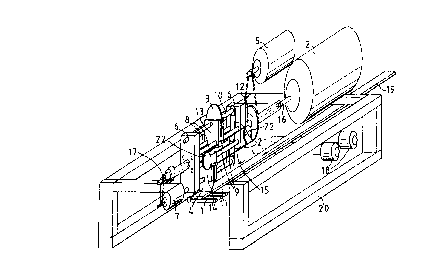Some of the information on this Web page has been provided by external sources. The Government of Canada is not responsible for the accuracy, reliability or currency of the information supplied by external sources. Users wishing to rely upon this information should consult directly with the source of the information. Content provided by external sources is not subject to official languages, privacy and accessibility requirements.
Any discrepancies in the text and image of the Claims and Abstract are due to differing posting times. Text of the Claims and Abstract are posted:
| (12) Patent: | (11) CA 2266548 |
|---|---|
| (54) English Title: | SAWING MACHINE |
| (54) French Title: | SCIE MECANIQUE |
| Status: | Expired and beyond the Period of Reversal |
| (51) International Patent Classification (IPC): |
|
|---|---|
| (72) Inventors : |
|
| (73) Owners : |
|
| (71) Applicants : |
|
| (74) Agent: | SMART & BIGGAR LP |
| (74) Associate agent: | |
| (45) Issued: | 2005-04-26 |
| (86) PCT Filing Date: | 1997-09-09 |
| (87) Open to Public Inspection: | 1998-04-02 |
| Examination requested: | 2002-08-22 |
| Availability of licence: | N/A |
| Dedicated to the Public: | N/A |
| (25) Language of filing: | English |
| Patent Cooperation Treaty (PCT): | Yes |
|---|---|
| (86) PCT Filing Number: | PCT/FI1997/000536 |
| (87) International Publication Number: | FI1997000536 |
| (85) National Entry: | 1999-03-23 |
| (30) Application Priority Data: | |||||||||
|---|---|---|---|---|---|---|---|---|---|
|
A sawing device for sawing a long object to a fixed size, said sawing device
comprising a conveyor (1) for conveying the object
to be sawn and blades (3, 4) rotated by a first power unit (2) for cutting the
object. The sawing device comprises a rotatable frame (6)
rotated by a second power unit (5), the blades (3, 4) bein supported by said
rotatable frame, a third power unit (7) and guide bars (8, 9) in
the rotatable frame to allow the blades (3, 4) to be moved back and forth by
the third power unit along the guide bars in the longitudinal
direction of the object to be sawn.
La présente invention concerne un équipement de scierie destiné à scier à cotes fixes un objet long. Cet équipement de scierie est constitué d'un chariot (1) servant à faire avancer l'objet à scier et de lames (3, 4) mises en rotation par un premier groupe moteur (2) de façon à couper l'objet. L'équipement de scierie comporte, d'une part un châssis rotatif (6) mis en rotation par un deuxième groupe moteur (5), les lames (3, 4) étant supportées par le châssis rotatif considéré, et d'autre part un troisième groupe moteur (7) et des barres de guidage (8, 9) montés sur le châssis rotatif de façon à permettre au troisième groupe moteur d'animer les lames d'un mouvement d'aller et retour avant-arrière, le long des barres de guidage dans le sens de la longueur de l'objet à scier.
Note: Claims are shown in the official language in which they were submitted.
Note: Descriptions are shown in the official language in which they were submitted.

2024-08-01:As part of the Next Generation Patents (NGP) transition, the Canadian Patents Database (CPD) now contains a more detailed Event History, which replicates the Event Log of our new back-office solution.
Please note that "Inactive:" events refers to events no longer in use in our new back-office solution.
For a clearer understanding of the status of the application/patent presented on this page, the site Disclaimer , as well as the definitions for Patent , Event History , Maintenance Fee and Payment History should be consulted.
| Description | Date |
|---|---|
| Time Limit for Reversal Expired | 2016-09-09 |
| Letter Sent | 2015-09-09 |
| Maintenance Request Received | 2014-09-09 |
| Maintenance Request Received | 2013-09-09 |
| Inactive: Late MF processed | 2008-01-15 |
| Letter Sent | 2007-09-10 |
| Grant by Issuance | 2005-04-26 |
| Inactive: Cover page published | 2005-04-25 |
| Pre-grant | 2005-02-11 |
| Inactive: Final fee received | 2005-02-11 |
| Notice of Allowance is Issued | 2004-09-03 |
| Notice of Allowance is Issued | 2004-09-03 |
| Letter Sent | 2004-09-03 |
| Inactive: Approved for allowance (AFA) | 2004-08-26 |
| Letter Sent | 2002-10-07 |
| Request for Examination Received | 2002-08-22 |
| Request for Examination Requirements Determined Compliant | 2002-08-22 |
| All Requirements for Examination Determined Compliant | 2002-08-22 |
| Inactive: Cover page published | 1999-05-31 |
| Inactive: First IPC assigned | 1999-05-10 |
| Inactive: IPC assigned | 1999-05-10 |
| Inactive: Notice - National entry - No RFE | 1999-04-27 |
| Inactive: Inventor deleted | 1999-04-26 |
| Application Received - PCT | 1999-04-23 |
| Small Entity Declaration Determined Compliant | 1999-03-23 |
| Application Published (Open to Public Inspection) | 1998-04-02 |
There is no abandonment history.
The last payment was received on 2004-08-17
Note : If the full payment has not been received on or before the date indicated, a further fee may be required which may be one of the following
Patent fees are adjusted on the 1st of January every year. The amounts above are the current amounts if received by December 31 of the current year.
Please refer to the CIPO
Patent Fees
web page to see all current fee amounts.
Note: Records showing the ownership history in alphabetical order.
| Current Owners on Record |
|---|
| AHTI NIEMELA |
| Past Owners on Record |
|---|
| None |